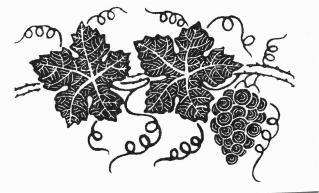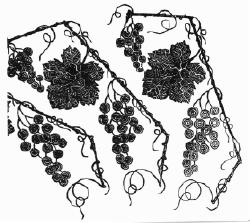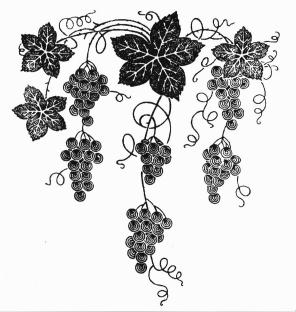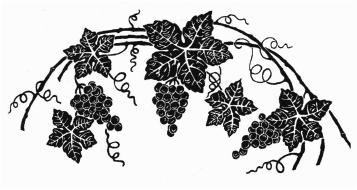Cambridge "Grapes"
by Mark A. Nye
Issue No. 148 - August 1985
"Grape - any of numerous woody vines of the Genus Vitis, bearing clusters of edible fruit and widely cultivated in many species and varieties." - The American Heritage Desk Dictionary. Using the preceding style of definition and with a few slightly different words, the subject of this article might perhaps be defined thusly: Cambridge Grape - any of several etchings showing a grape vine with clusters of grapes and believed by some existing primarily to confuse and otherwise cause problems for today's Cambridge collectors.
While it is true there is a Cambridge Grape pattern that is distinctive and cannot be confused with other Cambridge patterns, it is equally true most of the grape designs differ probably in name only, or else are so slightly different, existing catalog illustrations are not sufficient to distinguish between them. Hopefully in the boxes of Cambridge etching plates, purchased this past winter from the former Imperial Glass Corporation, we will find named and numbered plates that will resolve the conflict among the grape designs. Until the task of sorting, cleaning and cataloging the plates is completed, we, on several of the patterns, can only speculate.
A Cambridge catalog issued circa 1922 contained references to four grape etchings: Deep Plate Etched Grape #401; Deep Plate Etching #521; Martha; and Deep Plate Etching #533. The first three, as shown in the illustrations, are distinctive and will not be confused with each other. The #533 appears to be the same as Martha with the addition of a border etching.
 Grape #401 (shown at left), according to the price list that accompanied the 1922
catalog, was etched onto 27 items, primarily consisting of stemware,
tumblers and nappies. The stemware line used for this pattern was #7858
while the tumblers are from the #8858 series. Both the tumblers and the
stemware were available plain or, at an extra cost, optic. Except for a
few items that have a shallow bowl, Grape #401 is basically a border or
rim decoration. In the former instances due to the size of the bowl,
the pattern covers much of the item. For additional illustrations of
this etching, the reader is referred to the September 1980 issue of the
Cambridge CRYSTAL BALL, or to the Welker Book II of Catalog
Reprints.
Grape #401 (shown at left), according to the price list that accompanied the 1922
catalog, was etched onto 27 items, primarily consisting of stemware,
tumblers and nappies. The stemware line used for this pattern was #7858
while the tumblers are from the #8858 series. Both the tumblers and the
stemware were available plain or, at an extra cost, optic. Except for a
few items that have a shallow bowl, Grape #401 is basically a border or
rim decoration. In the former instances due to the size of the bowl,
the pattern covers much of the item. For additional illustrations of
this etching, the reader is referred to the September 1980 issue of the
Cambridge CRYSTAL BALL, or to the Welker Book II of Catalog
Reprints.
 Plate Etching #521 (shown at right) has the grape vines placed on a top to bottom
incline and with a beginning and end, unlike all other Cambridge grape
patterns which have the vines encircling the object. The #521 Grape
covers much of each piece it was placed on and was probably. a small
line with only 12 items listed on the 1922 price list. In addition to
those items shown etched #521 on page 91 of the Welker Book II of
Catalog Reprints, there is a finger bowl plate. The stemware used for
#521 is #3020 and there are two #521 etched jugs, #3000 4 1/2 pint jug,
and #106 jug and cover in 30 and 66 ounce sizes.
Plate Etching #521 (shown at right) has the grape vines placed on a top to bottom
incline and with a beginning and end, unlike all other Cambridge grape
patterns which have the vines encircling the object. The #521 Grape
covers much of each piece it was placed on and was probably. a small
line with only 12 items listed on the 1922 price list. In addition to
those items shown etched #521 on page 91 of the Welker Book II of
Catalog Reprints, there is a finger bowl plate. The stemware used for
#521 is #3020 and there are two #521 etched jugs, #3000 4 1/2 pint jug,
and #106 jug and cover in 30 and 66 ounce sizes.
 The third grape etching from 1922 is Martha (at left) and once again the grape
vines encircle the pieces but unlike #401, the Martha design extends
over much of the area that was practical to etch. Like the previous two
patterns, this line consisted mainly of drinking vessels, nappies and
jugs. There is a total of 24 items in the Martha line, including a
water bottle and tumbler, syrup with cover and under plate, #103 guest
room jug and tumbler, and the #107 66 oz. jug with cover. For
additional information on Martha, the reader is referred to the
Cambridge Crystal Ball of November 1983.
The third grape etching from 1922 is Martha (at left) and once again the grape
vines encircle the pieces but unlike #401, the Martha design extends
over much of the area that was practical to etch. Like the previous two
patterns, this line consisted mainly of drinking vessels, nappies and
jugs. There is a total of 24 items in the Martha line, including a
water bottle and tumbler, syrup with cover and under plate, #103 guest
room jug and tumbler, and the #107 66 oz. jug with cover. For
additional information on Martha, the reader is referred to the
Cambridge Crystal Ball of November 1983.
The #533, the fourth etching to feature grape vines during the early 1920s, appears to be similar, if not identical to Martha, but with the addition of an unrelated border etching. I have only been able to identify four items etched #533: #98 77 oz. jug; #1415 10 oz. tumbler; #107 66 oz. jug and cover; and the #8701 12 oz. tumbler.
So far, not too confusing? Rather simply a matter of learning the three different designs! But, the best--or worst--is yet to come.
In 1930 Cambridge brought out a general catalog and at least for the following four years, issued annual supplements compatible with this catalog. It is in this catalog, as reprinted by the NCC, Inc., that we really "get into the grapes."
 Our first grapes appear on page 50 of the original catalog, for
there is illustrated the Martha etching on the #797 8" vase. Simple
enough, right? Wrong! For on page 8 of the 1932 supplement appears the
#993 12½" bowl etched #757 (shown at left). Now #757 looks very much like our
friend Martha; however, we ask why the number and not the name? If they
are one in the same etching, then the number was assigned in the 1930s,
not when the etching was new, circa 1922, since it is a higher number
than numbers assigned to etchings known to have been introduced circa
1930, for example Apple Blossom or Etching #744. The page on which the
bowl is shown deals entirely with console sets and all the other
etchings are identified by number and hence Cambridge might have
assigned a number to Martha for consistency's sake.
Our first grapes appear on page 50 of the original catalog, for
there is illustrated the Martha etching on the #797 8" vase. Simple
enough, right? Wrong! For on page 8 of the 1932 supplement appears the
#993 12½" bowl etched #757 (shown at left). Now #757 looks very much like our
friend Martha; however, we ask why the number and not the name? If they
are one in the same etching, then the number was assigned in the 1930s,
not when the etching was new, circa 1922, since it is a higher number
than numbers assigned to etchings known to have been introduced circa
1930, for example Apple Blossom or Etching #744. The page on which the
bowl is shown deals entirely with console sets and all the other
etchings are identified by number and hence Cambridge might have
assigned a number to Martha for consistency's sake.
On page 10 of the 1932 supplement, and adding to the building confusion, we find three Georgian tumblers etched with a design called "E/Grape." Definitely not #401 or #521, it does, however, look a great deal like Martha. Is it Martha or a variant, impossible to say based on the available evidence.
At least the next 1932 grape pattern is straight forward. It was a reuse of #401 with a new name. "Old Fashioned Grape" #401." Shown on page 12 of the 1932 Cambridge catalog supplement, it was placed onto #1400 and #1401 stemware, two styles of tumblers, #1203 and #1204, and on the #1401 finger bowl.
Is it possible someone at Cambridge "was into the grape" during 1931-32? Just when things were appearing simple, we find, on page 24 of the 1932 supplement, Martha Washington blanks etched with what is called "Grape." This is not the "E/Grape" that appeared on the Georgian tumblers but rather appears similar to #401. It is anybody's guess why it was called "Grape," not Old Fashioned Grape or #401. Thus, there is now the problem of two etchings called Grape that are certainly not the same and there is still more to come.
Remaining with the 1932 supplement, on page 33, there is a Tally-Ho #1402/2 14 oz. goblet illustrated etched Catawba. This etching appears to be very similar to Martha and if there is any difference at all, it is in the "vines" portion of the design. The only other known reference to Catawba is found in China, Glass and Lamps for January 1933, when it was shown on the Tally-Ho #1402/38 decanter and the #1402/37 2½ oz. handled tumbler. Though yet unproven, it is possible this particular etching was used only on Tally-Ho blanks.
We are most fortunate ... no grapes in 1933! But then there is always 1934 to look forward to. On page 3 of the catalog supplement issued that year we find an etching called Bacchus on #7966 stemware and what do you know, it is a grape design! Is it a new one? Well, look for yourself. It is not Martha, that much is obvious, being simpler than that pattern. It does, however, look very much like the "grape" of Martha Washington fame and #401. Are they the same, I really can't say nor can I state that they are different. Shown only on stemware and tumblers, it has not been determined if there is flatware etched Bacchus.
 Appropriately named "Vintage", (shown at left) our final etched Grape pattern
appears on pages 7-8 of the 1934 catalog supplement. Here we find the
etching on #3109 stemware and tumblers that look very similar to #7858
stemware and #8858 tumblers from 1922 and Grape #401 fame. Not only are
the blanks look-a-likes, but so is the grape pattern since Vintage
closely resembles the 1922 Deep Plate Etched Grape #401. Is either the
glass or the etching identical to its predecessor? If not, then the
differences cannot be clearly discerned from catalog illustrations.
Vintage, like #401, is basically a border type design and one used
primarily for stemware and tumblers.
Appropriately named "Vintage", (shown at left) our final etched Grape pattern
appears on pages 7-8 of the 1934 catalog supplement. Here we find the
etching on #3109 stemware and tumblers that look very similar to #7858
stemware and #8858 tumblers from 1922 and Grape #401 fame. Not only are
the blanks look-a-likes, but so is the grape pattern since Vintage
closely resembles the 1922 Deep Plate Etched Grape #401. Is either the
glass or the etching identical to its predecessor? If not, then the
differences cannot be clearly discerned from catalog illustrations.
Vintage, like #401, is basically a border type design and one used
primarily for stemware and tumblers.
In summary, there appears to be three basic Cambridge grape etchings: #401; #521; and Martha; all dating to circa 1922. The #401 group of look-a-likes includes: Old Fashioned Grape; Grape; Bacchus; and Vintage. The second or Martha group consists of: #533; #575; E/Grape; and Catawba. Do we have ten different grape designs or three? That is the question that must eventually be answered. My own feeling is that there is closer to three, if not three, etchings than ten.
None of the grape etchings survived the 1930s. None appear in the 1940 or later issued Cambridge catalogs. One does not find any great quantity of grape etchings in today's resale market, this may be in part due to the problems associated with pattern identification and attribution to the proper glass manufacturer. Many glass houses produced one or more grape etchings, many of which are similar, and combined with pulled stemware this presents a monumental problem in identification, one that many dealers and even collectors do not wish to spend the time resolving.
